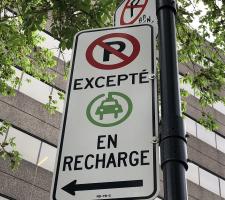
*Bibendum is the original name for the Michelin Man, the symbol of the
Autonomous vehicles, platooning, smart intersections and safety – these were the talking points over two-and-a-half days of the Movin’ On event in Montreal, Canada. Everyone in the mobility sector is at the same point, trying to see what mobility will look like in the future – which is closer than most people think.
Apparent at the event was just how many non-traditional automotive companies and agencies are already working to create this future.Vehicle manufacturers still have a role to play, but as they invest in designing autonomous cars, they are having to work with Silicon Valley companies to produce cars that can collect data from the environment ahead. Urban road designers are hooked up with sensor developers to create intersections that gather information from approaching vehicles in order to time traffic lights. It is creating strange bedfellows as the mobility sector travels down the unknown road. Even Michelin, a traditional manufacturer of tyres and creator of the Movin’ On event (formerly called Bibendum after Michelin’s iconic trade mark*), is aware of the challenges.
It was by any standard a bold statement from the head of Michelin urging people to run their tyres down to the wear limit before changing them. Jean-Dominique Senard, chief executive of Michelin, said he was passionate about the environment and better mobility. He recalled, for the attendees, that Michelin had developed its Green X tyre standards in the 1990s to improve tyre wear while reducing rolling resistance in order to help boost a vehicle’s fuel efficiency.
Tyres, he said, are designed to be safe up to that wear point. Replacing tyres before the wear line is reached is needlessly adding to the recycling mountain – even though to do so would see Michelin selling more tyres to drivers. But then, the conference subhead was ‘World Summit on Sustainable Mobility’.
Mobility for whom?
Think Fred Astaire and Ginger Rogers, except on roller skates. That was the opening act under the Movin’ On event’s main Big Top venue. Attendees watched the man and woman glide around, spin and generally contort themselves as if on roller skates.
These days, roller skating around town is – at least for some people in an urban environment - simply their mobility choice.
A decade ago, people were asked if they want better transport. Today this is a given, said Montreal mayor Valérie Plante, who ran her 2017 election campaign partly on getting better mobility for the city. Immediately after being elected, the city ordered 300 hybrid buses.
Now when people ask the question, the answer is they want ‘more choice’. The trick to putting in place and executing a successful mobility policy is “not to put drivers in opposition” to the policy, she said. “People want flexibility”, including the use of their own car. This is an important point for inclusivity of a mobility plan, noted Kate White, deputy secretary for environmental policy and housing co-ordination within the California State Transportation Agency. Before joining the agency, she was a founder of
In many cases there will have to be a logical argument to ween vehicle owners off their cars, said Bertrand Piccard, president of Solar Impulse Foundation. “What is the logic of environmentally friendly technology?” he asked. “It has to be personal and likely profitable in some way.” Piccard co-piloted a solar-powered electric plane 40,000km around the world in 2016.
This is a good example of what is achievable: solar-powered electric flight can be done with today’s technology. However, until the accomplishment of his own flight, governments and investors all said it could not be done. Afterwards, many were interested in investing in the technology in some way. There became a logic, he said, based on profitability.
Piccard added that on the one hand “it would be beautiful to see a traffic jam of electric cars”. But before it got to that point, regulation and infrastructure should be in place to prevent such traffic jams. He believes regulation at national level will be most hard to implement. It will likely be city authorities that have the real and final say in how tomorrow’s mobility choices shape up.
Mobility choices
In fact, there was agreement by many speakers and panellists at Movin’ On that development of mobility choices and accompanying technologies will have to be regulated in some fashion. But at what government level?
The Canadian Pacific coast city of Vancouver has had to regulate over the issue of “who owns the kerb?”, said Swiss-born Sandra Phillips who is chief executive of movmi Shared Transportation Services. Vancouver has 31,000 registered users of car-share schemes. Where these cars are parked when not in use has been a problem that has been solved by city regulations. The car-share cars may park in residential areas at certain times of the day and are banned from meter parking in the city centre.
Regarding the phasing out of fossil-fuel vehicles, it may be a small central American country that completes the task before other nation states. If Costa Rica can phase out its military forces, as it progressively did over several years from 1948, it stands a good chance of getting petrol and diesel vehicles off the nation’s roads, said Monica Araya, an economist and a director of Costa Rica Limpia, which promotes renewable energy and electric transport.
Carlos Alvarado, a 38-year-old former journalist and Costa Rica’s new president, made an announcement in early May at his inauguration that the country would get rid of fossil fuel vehicles – though no date has been set. The month before he promised to phase out public transportation using gasoline and diesel by 2021, Costa Rica’s 200th year of independence.
Much of the world’s media claimed that he had banned fossil-fuel vehicles. Not quite true, said Araya, during her own presentation at Movin’ On. Alvarado announced to a crowd of thousands during his inauguration that “decarbonisation is the great task of our generation and Costa Rica must be one of the first countries in the world to accomplish it, if not the first.” Symbolically, Alvarado arrived at the ceremony in the capital San Jose aboard a hydrogen-fuelled bus.
Costa Rica already generates more than 99% of its electricity from renewable sources. But energy experts have cautioned that achieving zero-carbon transport quickly would be a real challenge.
Fossil fuel challenge
Araya agreed that banning fossil fuel vehicles will be a true test. However, there isn’t necessarily a looming outright ban. As the country moves more and more toward zero-carbon transport, the market for fossil-fuel vehicles will simply wither away. It is part of the national ‘Pura Vida’, meaning literally pure life, but also in this context it means ‘living well’ or ‘going great’. Costa Ricans already know that Pura Vida is connected to carbon-free transport, she said.
Still, she insists, increasing the market for non-fossil fuel vehicles must mean a “government public relations campaign” to “make people proud” of going non-fossil fuel. As demand for petrol and diesel vehicles diminishes, so will the availability of the fuel, creating a downward spiral to level zero. It will, she said, be a banning in all but name.
Geodis, the logistics division of
As for manufacturing electric vehicles to support carbon-zero policies, Ursula Mathar, vice president of sustainability and environmental protection at BMW, said there is no getting away from the need for some regulation to push the sales of electric vehicles. Despite the rising increase in demand and sales of electric vehicles, “without regulatory incentives, electric vehicles are just not big business for us, only 1% of the automotive market”.
Mathar suggested that incentives can take many shapes, such as financial incentives to buy electric vehicles, parking discounts and even end-of-life or recycling rebates.
Safety looming
Meanwhile, there is the looming issue over safety - not only of autonomous cars but the mix of autonomous, semi-autonomous and non-autonomous vehicles (AVs), said Don Civgin, president of the emerging businesses division within the large US insurance provider Allstate.
He pointed out that if one death occurs because of a driverless car accident, there is a major uproar about safety. But, he said, that with 40,000 deaths annually right now on US roads, if driverless cars can halve that, then it will be positive in the argument for more driverless cars. Unless data is available to support the case that autonomous and semi-autonomous vehicles are making the roads safer, said Civgin, then accidents involving these vehicles will continue to get large headlines in the media.
Safety rates of AVs will likely come down to how well they are digitally connected to their environment, including other AVs, said Shi Weiliang, general manager of
If that be the case, then artificial intelligence (AI) will be the battlefield of future mobility. “There is no data on earth that wasn’t gathered without having a purpose,” said Jean-François Gagné, co-founder and chief executive of Element AI, a Montreal-based consultancy that helps organisations mould AI data into useable products for whatever sphere of life. Gagné acknowledged that one of the biggest challenges emerging is governance over data collection and usage rights – especially true if machines are able to learn from new experiences and reuse information. Governments will have no option but to step in and regulate data use and storage, said Gagné.
In fact, he said, “the right regulatory framework will allow companies to innovate and build trust with the public”. Without trust, the public will not use the products, systems and technologies, deeming them data-insecure or simply not a physically safe mobility option. “With no such trust then we, the private sector, can’t easily introduce safety features.”
Brake it up
There were times during his two appearances on panel discussions that Joshua Schank, chief innovation officer with the Los Angeles County Metro, in California, threw the anchors out concerning AI and the wonderful transportation options it will open up to urban dwellers. City authorities still must decide which mobility technologies, systems and products will bring the most choice and benefit to those who really need choice. Are people getting to work with less stress and less cost to themselves? Does it take them to where they need to go?
These questions will have to be answered by cities and their private sector partners, said Schank. That may mean some apparently innovative systems and technologies will be curtailed. For example, will an increasing number of ride-hail taxies clog up the streets and slow down traffic in general?
Los Angeles has a great disparity of users to which the city has an obligation. It must examine carefully the benefit of systems, technologies and products which, because of their relatively high cost of use, might exclude people less well-off financially, he went on.
A ride-hailing venture may get a licence if it has tariffs that are lower in less wealthy areas. In this way, mobility choice can act for the greater good, said Schank. But he didn’t shy away from what he believes will be some tough talk between the private sector and public sector on what technologies will be included in urban mobility.
Let the train take the strain
The focus of many discussions at Movin’ On was on cities and not so much on intercity travel. For extra-city transportation, people might be wedded to petrol and diesel transportation for several decades to come.
But the old ‘iron horse’ still has a role to play in the connected transport system, said Guillaume Pepy, president of France’s national government-owned train operator SNCF.
Trains are getting cleaner and faster and “the future of rail is to be part of this greater mobility system”, said Pepy, who is also chief executive of SNCF Mobilités, a public and non-commercial organisation. SNCF intends to roll out a “personal multimodal mobility assistant” by 2025. This ‘always-on’ digital travel partner will analyse a user’s travels and will integrate them with other available mobility offers on the market, apart from from train, across all modes of transport, to give the customer a door-to-door service.
Train companies deliver people city centre-to-city centre, explained Pepy, who also noted that he doesn’t own a car. The word ‘deliver’ is the key. Similar to post offices worldwide, the last mile is the most important part of a passenger’s voyage. For that reason, SNCF is looking at working with ride-hailing companies and others to provide a seamless trip from home to starting train station, the starting train ride proper - and finally from the end station to the final destination, wherever that may be in the city or urban area.
Final-mile solution
Are cars and trains in competition for such journeys? Pepy likes to call it ‘co-competition’, where at times they compete – people take the train instead of the car – and then co-operate through providing a final-mile solution, using the car after a train journey to a city centre. This choice is happening under SNCF’s Core and Explore programme. In October, said Pepy, SNCF will launch its personal mobility app that will help people do just that and much more.
Train stations, too, at least in Europe, are becoming much more than just a place to catch a train. Massive city redevelopment is taking place in, and around, train stations. As they are often the visitor’s first impression of a city, train stations are now ‘city boosters’ which put a city’s best foot forward, he suggested. They are places to shop, eat, relax before a trip and to meet people, whether a trip is ahead or not.
St Pancras and King’s Cross stations in London are two examples. Similarly in Paris, the huge Gare du Nord station – a terminus of the Eurostar service from London, UK - is about to undergo a €500 million redevelopment. He said that SNCF will maintain 100% of services – 2,000 trains a day – to ensure mobility for around 850,000 daily users.










